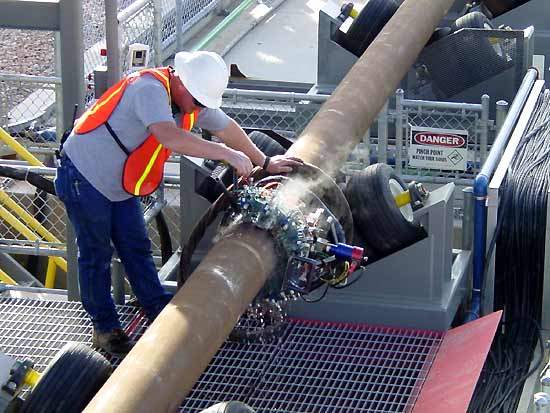Complete Pipeline Welding Inspection Solutions for Industrial Projects
Complete Pipeline Welding Inspection Solutions for Industrial Projects
Blog Article
Comprehensive Review of Pipeline Welding Inspection Procedures
In the world of pipe building and construction, making sure the integrity and security of bonded joints is vital. Pipe welding assessment procedures play an important duty in guaranteeing that welded connections meet stringent market standards and specs. From careful pre-welding evaluations to extensive post-weld evaluations, a well-defined examination procedure is important for maintaining the architectural sturdiness of pipes. Understanding the complexities of welding evaluation procedures is not only a regulatory demand but likewise an essential facet of supporting the reliability of these critical infrastructures.
Pre-welding Inspection Preparations
Before starting the welding process, thorough pre-welding assessment prep work are essential to guarantee the honesty and quality of the weld joint. These prep work involve a thorough examination of the products to be bonded, the welding tools, and the work setting. By conducting complete pre-welding inspection preparations, potential issues can be identified and settled early on, leading to reliable and premium weld joints.
Welding Treatment Credentials
Extensive pre-welding examination preparations lay the foundation for the crucial procedure of Welding Treatment Credentials, making sure the stability and top quality of the weld joint. Welding Procedure Qualification (WPQ) is an important action in the welding process that involves screening and accrediting welding procedures to assure they fulfill specific standards and demands. The WPQ process typically consists of welding procedure specification growth, welding procedure qualification testing, and paperwork of the outcomes.
During welding treatment requirements advancement, crucial details such as the welding procedure, welding products, joint layout, and welding specifications are defined to produce a comprehensive treatment. Subsequently, welding procedure credentials screening is performed to verify the suggested treatment's stability. This testing usually includes welding test discount coupons that go through different mechanical and non-destructive tests to assess the weld's quality and adherence to the specified standards.
In-process Weld Evaluation
Throughout the welding process, in-process weld inspection plays a critical role in making sure the high quality and honesty of the weld joint - Pipeline Welding Inspection. This type of evaluation includes keeping an eye on the welding criteria, assessing the weld bead formation, and discovering any kind of potential problems or gaps as they happen. By carrying out in-process weld evaluations, welding drivers can quickly address any problems that might emerge, therefore avoiding more defects and ensuring that the last weld fulfills the required requirements
Typical approaches made use of for in-process weld evaluation include visual examination, fluid penetrant testing, magnetic particle screening, ultrasonic testing, and radiographic testing. Overall, in-process weld assessment is necessary for keeping the top quality and dependability of welded pipelines.
Non-destructive Screening (NDT)
Non-destructive Testing (NDT) is an important approach used in pipeline welding examination to examine the honesty of weld joints without creating damage to the bonded framework. By using numerous NDT strategies, assessors can review the top quality of welds and determine any type of flaws or interruptions that might endanger the architectural stability of the pipe. Common NDT methods utilized my latest blog post in pipeline welding examination consist of Radiographic Testing (RT), Ultrasonic Screening (UT), Magnetic Particle Examining (MPT), Liquid Penetrant Screening (LPT), and Visual Screening (VT)
RT involves using X-rays or gamma rays to generate photos of the internal framework of the weld, allowing examiners to discover problems such as porosity, fractures, or incomplete fusion. UT uses high-frequency audio waves to find problems under the surface area of the weld, supplying comprehensive information regarding the size and location of flaws. MPT and LPT are utilized to determine surface-breaking defects by using penetrant liquids or magnetic particles to the weld location. Additionally, VT entails aesthetic inspection of welds to identify any kind of visible flaws.
Post-weld Inspection and Documents


Paperwork of post-weld assessment searchings for is crucial for preserving quality control documents and making certain compliance with industry standards and guidelines. Thorough records must consist of information concerning the examination methods made use of, the place and nature of any flaws discovered, and any kind of corrective activities taken - Pipeline Welding Inspection. Appropriate documents not just offers as a document of the weld's quality but also aids in future upkeep and inspection procedures
Conclusion

To conclude, pipeline welding inspection treatments play an essential duty in making sure the quality and stability of welds. From pre-welding assessments to post-weld documents, each step is vital in preserving the safety and effectiveness of pipelines. By following recognized procedures and carrying out comprehensive examinations, possible problems can be determined and resolved prior to they result in expensive repairs or failings. In general, adherence to appropriate evaluation methods is vital to the success of pipe welding jobs.
From careful pre-welding assessments to thorough post-weld assessments, a distinct evaluation process is important for maintaining the architectural soundness of pipelines. By carrying out in-process weld evaluations, welding operators can quickly address any type of problems that might emerge, thereby making certain and stopping additional issues site here that the last weld satisfies the required specs.
Common approaches made use of for in-process weld inspection consist of aesthetic assessment, fluid penetrant screening, magnetic bit screening, ultrasonic screening, and radiographic testing.Non-destructive Screening (NDT) is a crucial technique utilized in pipeline welding inspection to evaluate the integrity of weld joints without causing damage to the welded framework. Post-weld evaluation entails numerous approaches to evaluate the welds for problems, including visual examination, dye penetrant testing, magnetic bit testing, ultrasonic testing, and radiographic testing.
Report this page